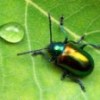I did not expect everyone to nearly instantaneously solve yesterday's termite ball mystery. I'm either going to have to post more difficult challenges (from now on, nothing will be in focus!) or attract a slower class of reader.
As you surmised, those little orange balls are an egg-mimicking fungus. It is related to free-living soil fungi, but this one has adopted a novel growth form that is similar in diameter, texture, and surface chemistry to the eggs of Reticulitermes termites. These hardened sclerotia are carried about the termite nest as if they were the termite's own offspring, earning them the title "Cuckoo fungus". Since termites are blind there is no advantage to the fungus in visually looking like an egg, though, so we sighted creatures can tell the difference at a glance.
For more about the Cuckoo fungus, check out the publications of Kenji Matsuura. Matsuura first identified the balls as a fungus ten years ago, as a graduate student, and has been working on them ever since.



If it makes you feel any better, I had no clue.
Well, if they're only mimicking eggs, what are they going to eat and how would they reproduce?
I'm with wildwoodflwr: I didn't have a clue what they were.
Me three...I had no idea...
but I'll never forget now! What a cool story!!!